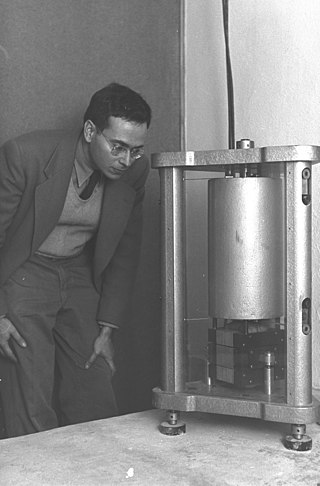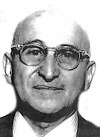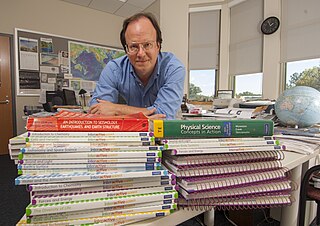Related Research Articles

Seismology is the scientific study of earthquakes and the generation and propagation of elastic waves through the Earth or other planetary bodies. It also includes studies of earthquake environmental effects such as tsunamis as well as diverse seismic sources such as volcanic, tectonic, glacial, fluvial, oceanic microseism, atmospheric, and artificial processes such as explosions and human activities. A related field that uses geology to infer information regarding past earthquakes is paleoseismology. A recording of Earth motion as a function of time, created by a seismograph is called a seismogram. A seismologist is a scientist works in basic or applied seismology.

Frank Press was an American geophysicist. He was an advisor to four U.S. presidents, and later served two consecutive terms as president of the U.S. National Academy of Sciences (1981–1993). He was the author of 160 scientific papers and co-author of the textbooks Earth and Understanding Earth.

Beno Gutenberg was a German-American seismologist who made several important contributions to the science. He was a colleague and mentor of Charles Francis Richter at the California Institute of Technology and Richter's collaborator in developing the Richter magnitude scale for measuring an earthquake's magnitude.

Hiroo Kanamori is a Japanese seismologist who has made fundamental contributions to understanding the physics of earthquakes and the tectonic processes that cause them.

Theory X and Theory Y are theories of human work motivation and management. They were created by Douglas McGregor while he was working at the MIT Sloan School of Management in the 1950s, and developed further in the 1960s. McGregor's work was rooted in motivation theory alongside the works of Abraham Maslow, who created the hierarchy of needs. The two theories proposed by McGregor describe contrasting models of workforce motivation applied by managers in human resource management, organizational behavior, organizational communication and organizational development. Theory X explains the importance of heightened supervision, external rewards, and penalties, while Theory Y highlights the motivating role of job satisfaction and encourages workers to approach tasks without direct supervision. Management use of Theory X and Theory Y can affect employee motivation and productivity in different ways, and managers may choose to implement strategies from both theories into their practices.

The petroleum industry, also known as the oil industry or the oil patch, includes the global processes of exploration, extraction, refining, transportation, and marketing of petroleum products. The largest volume products of the industry are fuel oil and gasoline (petrol). Petroleum is also the raw material for many chemical products, including pharmaceuticals, solvents, fertilizers, pesticides, synthetic fragrances, and plastics. The industry is usually divided into three major components: upstream, midstream, and downstream. Upstream regards exploration and extraction of crude oil, midstream encompasses transportation and storage of crude, and downstream concerns refining crude oil into various end products.
Mission-type tactics is a method of command and delegation where the military commander gives subordinate leaders a clearly-defined objective, high-level details such as a timeframe, and the forces needed to accomplish that objective. The subordinate leaders are given the planning initiative and freedom of execution: they decide on the methods to achieve the objective independently. This allows a high degree of flexibility at the operational and tactical levels of command, which allows for faster decision-making on the ground and frees the higher leadership from managing the tactical details to concentrate on the strategic picture. This may be contrasted with "Befehlstaktik" or command-type tactics.
The Petroleum Production Company Nobel Brothers, Limited, or Branobel, was an oil company set up by Ludvig Nobel and Baron Peter von Bilderling. It operated mainly in Baku, Azerbaijan, but also in Cheleken, Turkmenistan. Originally established by Robert Nobel and the investments of barons Peter von Bilderling and Standertskjöld as a distillery in 1876, it became, during the late-19th century, one of the largest oil-companies in the world.
Mission command, also referred to as mission-type tactics, is a style of military command, which is derived from the Prussian-pioneered mission-type tactics doctrine, combines centralized intent with decentralized execution subsidiarity, and promotes freedom and speed of action, and initiative within defined constraints. Subordinates, understanding the commander's intentions, their own missions, and the context of those missions, are told what effect they are to achieve and the reason that it needs to be achieved. Subordinates then decide within their delegated freedom of action how best to achieve their missions. Orders focus on providing intent, control measures, and objectives and allow for greater freedom of action by subordinate commanders. Mission command is closely related to civilian management concept of workplace empowerment, and its use in business has been explored by writers such as Bungay (2011) and Tozer. It is advocated but not always used by the militaries of the United States, Canada, Netherlands, Australia and the United Kingdom. Mission command is compatible with modern military net-centric concepts, and less centralized approaches to command and control (C2) in general.

The petroleum industry in Azerbaijan produces about 873,260 barrels (138,837 m3) of oil per day and 29 billion cubic meters of gas per year as of 2013. Azerbaijan is one of the birthplaces of the oil industry.

Command and control is a "set of organizational and technical attributes and processes ... [that] employs human, physical, and information resources to solve problems and accomplish missions" to achieve the goals of an organization or enterprise, according to a 2015 definition by military scientists Marius Vassiliou, David S. Alberts, and Jonathan R. Agre. The term often refers to a military system.
David Stephen Alberts is a former American Director of Research for the Office of the Assistant Secretary of Defense for Networks and Information Integration (NII).

While the local use of oil goes back many centuries, the modern petroleum industry along with its outputs and modern applications are of a recent origin. Petroleum's status as a key component of politics, society, and technology has its roots in the coal and kerosene industry of the late 19th century. One of the earliest instances of this is the refining of paraffin from crude oil. Abraham Gesner developed a process to refine a liquid fuel from coal, bitumen and oil shale; it burned more cleanly and was cheaper than whale oil. James Young in 1847 noticed a natural petroleum seepage when he distilled a light thin oil suitable for use as lamp oil, at the same time obtaining a thicker oil suitable for lubricating machinery. The world's first refineries and modern oil wells were established in the mid-19th century. While petroleum industries developed in several countries during the nineteenth century, the two giants were the United States and the Russian Empire, specifically that part of it that today forms the territory of independent Azerbaijan. Together, these two countries produced 97% of the world's oil over the course of the nineteenth century.

The 1891 Mino–Owari earthquake struck the Japanese provinces of Mino and Owari in the Nōbi Plain in the early morning of October 28 with a surface wave magnitude of 8.0 and moment magnitude of 7.5. The event, also referred to as the Nōbi earthquake, the Great Gifu earthquake, or the Great Nōbi earthquake, is the largest known inland earthquake to have occurred in the Japanese archipelago.

Michael E. Wysession is a professor of Earth and Planetary Sciences at Washington University in St. Louis, and author of numerous science textbooks published by Pearson Education, Prentice Hall and the Savvas Learning Corporation. Wysession has made many contributions to geoscience education and literacy, including chairing the inclusion of Earth and space science in the U.S. National Academy of Science report A Framework for K-12 Science Education and the U.S. K-12 Next Generation Science Standards
Philip E. Agre is an American AI researcher and humanities professor, formerly a faculty member at the University of California, Los Angeles. He is known for his critiques of technology. He was successively the publisher of The Network Observer (TNO) and The Red Rock Eater News Service (RRE). TNO ran from January 1994 to July 1996. RRE, an influential mailing list he started in the mid-1990s, ran for around a decade. A mix of news, Internet policy and politics, RRE served as a model for many of today's political blogs and online newsletters.
The chain-linked model or Kline model of innovation was introduced by mechanical engineer Stephen J. Kline in 1985, and further described by Kline and economist Nathan Rosenberg in 1986. The chain-linked model is an attempt to describe complexities in the innovation process. The model is regarded as Kline's most significant contribution.
Karen Cook McNally was an American seismologist.
The Advanced National Seismic System (ANSS) is a collaboration of the U.S. Geological Survey (USGS) and regional, state, and academic partners that collects and analyzes data on significant earthquakes to provide near real-time information to emergency responders and officials, the news media, and the public. Such information is used to anticipate the likely severity and extent of damage, and to guide decisions on the responses needed.
The World-Wide Standardized Seismograph Network (WWSSN) – originally the World-Wide Network of Seismograph Stations (WWNSS) – was a global network of about 120 seismograph stations built in the 1960s that generated an unprecedented collection of high quality seismic data. This data enabled seismology to become a quantitative science, elucidated the focal mechanisms of earthquakes and the structure of the Earth's crust, and contributed to the development of plate tectonic theory. The WWSSN is credited with spurring a renaissance in seismological research.
References
- ↑ Stein, Seth, and Michael Wysession (2009). An Introduction to Seismology, Earthquakes, and Earth Structures. New York: Wiley. pp. 313, 317, 484. ISBN 0865420785, ISBN 978-0865420786
- ↑ Bercovici, David (2007) (Ed). Treatise on Geophysics Vol. 7: Mantle Dynamics. (Treatise Editor-in-Chief Gerald Schubert). Amsterdam: Elsevier. pp 326,331,351,369,370. ISBN 0444534563, ISBN 978-0444534569
- ↑ Lee, William, Paul Jennings, Carl Kisslinger, and Hiroo Kanamori (2002). International Handbook of Earthquake and Engineering Seismology Part A. New York: Academic Press. pp 74,78. ISBN 0-12-440652-1, ISBN 978-0-12-440652-0
- ↑ Howell, B.F. (2005). Introduction to Seismological Research: History and Development. New York: Cambridge University Press. pp 113-115,117. ISBN 0521675510 ISBN 978-0521675512
- ↑ Koyama, Junji (1996). The Complex Faulting Process of Earthquakes. New York: Springer. pp. 111,187. ISBN 0792344995; ISBN 978-0792344995
- ↑ Ahrens, T.J. (1995) (Ed). Handbook of Physical Constants, Vol. 2: Mineral Physics and Crystallography. Washington, D. C.: American Geophysical Union. p. 183. ISBN 0-87590-852-7
- ↑ Marius S. Vassiliou (2018), Historical Dictionary of the Petroleum Industry, 2nd Edition. Rowman and Littlefield), 621pp. ISBN 1538111594, ISBN 978-1-5381-1159-8
- ↑ Kraut, Edgar A. (2007). Fundamentals of Mathematical Physics. New York: Dover Publications. See p.460.
- ↑ Seminario, J.M. (1996). Recent Developments and Applications of Modern Density Functional Theory. Amsterdam: Elsevier. p. 463.
- ↑ Ram-Mohan, Ramdas (2002). Finite Element and Boundary Element Applications in Quantum Mechanics. New York: Oxford University Press, 624pp. pp. 469,594. ISBN 0198525222, ISBN 978-0198525226.
- ↑ Pfalzner, Susanne, and Paul Gibbon (2008). Many-Body Tree Methods in Physics. New York: Cambridge University Press, 184pp. pp 147,159,162. ISBN 0521019168, ISBN 978-0521019163
- ↑ Rose, Paul (2002). Advanced Displays and Interactive Displays Federated Laboratory Report Compendium III: Final Report. Adelphi, MD: United States Army Research Laboratory, Report ARL-SR-115. pp 16,66,101,109,110.
- ↑ Vassiliou, M.S. (2007), "The Virtual Research Laboratory," Proc. 2007 IEEE Aerospace Conference.
- ↑ Avery, Benjamin, Ross T. Smith, Wayne Piekarski, and Bruce H. Thomas (2010). Engineering Mixed Reality Systems. New York: Springer. See Chapter 11.
- ↑ Vassiliou, M.S.and David Alberts (2012), "Megatrends Influencing C2," Proc. 2012 International Command and Control Research and Technology Symposium.
- ↑ Vassiliou, M.S. and David Alberts (2013), "C2 Failures: A Taxonomy and Analysis," Proc. 2013 International Command and Control Research and Technology Symposium.
- ↑ Vassiliou, Marius et al. (2013), "Crucial Differences Between Military and Commercial Needs in Communications Technology." Invited Paper, Proc. IEEE Milcom 2013."
- ↑ Vassiliou, Marius, David S. Alberts, and Jonathan R. Agre (2015). "C2 Re-Envisioned: the Future of the Enterprise." New York: CRC Press.
- ↑ Vassiliou, Marius, David S. Alberts, and Jonathan R. Agre (2017). C2 Re-Envisioned: the Future of the Enterprise (Chinese Edition). Beijing: National Defense Industry Press.
- ↑ Vassiliou, Marius; Mir-Babayev, Mir-Yusef (November 4, 2022). US and Azerbaijani Oil in the Nineteenth Century: The Two Titans. Lexington Books. p. 182. ISBN 978-1-7936-2952-4.